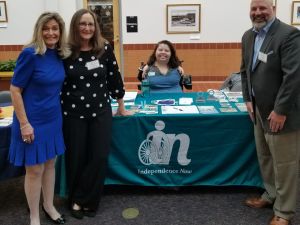Research in Practice- Strategic Collaboration: Student Voice in the IEP

Spotlight – Stories from the Field
Emily Summerlot, Prince George’s County Public Schools
Emily’s Challenge: How can IEP case managers increase collaboration with students during IEP development to ensure the IEP includes the student voice?
Emily Summerlot works in secondary special education in Prince George’s County and found herself wondering how to ensure that her students were active contributors to the development of their own IEPs. Some of the IEPs she encountered had limited information in the student interests and strengths area, an often overlooked portion of the IEP that can be very beneficial to teachers in building student engagement and interest, resulting in positive outcomes. As part of her instruction, she began to embed conversations about personal interests and self-reflection about the use of various accommodations and supports into 1:1 check-ins and small group sessions that occurred during independent practice times. Within a few weeks, students were sharing their interests with the teacher and with their peers and providing their one views on the benefits (or not) of the support provided for a given assignment. Their input was then used to inform the writing/revising of their IEPs.
| “I learned that if I need help on something, it doesn’t matter how big or small, I need to ask for help.” – Student participant |
| “We added a self-management goal… this way, he had the support he needed while working toward the goal and the awareness that the IEP was based on his input. We also discussed that once he achieved the goal, then the IEP could be revised to remove the supplementary aid or reduce its frequency because he would no longer need as much encouragement to ask for help. Again, this discussion reinforced that his progress and effort would directly influence the IEP.” – Emily Summerlot |
Implementation Plan
Time: 2-3 minutes per student – weekly or bi-weekly
Materials/Resources: weekly or bi-weekly small group or 1:1 instruction time, self-assessment question list
Steps:
- During small group or 1:1 instruction, ask students follow up questions to gauge interest areas.
- To help prompt students to share information, use questions related to the content to encourage them to share. For example, “In The Shadowshapers, Sierra loved art and hanging out with her friends…What do you like to do when you aren’t at school?” OR “Sierra’s friends said she was a good listener. What do your friends think you are good at? Do you agree with them?”
- Use a tracking sheet to record the student interest areas and strengths. When developing the IEP use this information to add detail to the student interests/strengths section.
- During that same check-in or small group instruction, use tools such as these question stems* to help students think about the assignment and what is challenging and what helps them succeed.
- Record their responses on your student-input tracking sheet.
- After several self-reflection opportunities, hold a short 1:1 check in and ask the student to look at the list of supplementary aids and services and accommodations on their IEP with you. Compare what is on the list to their self-reflections and discuss what may be needed added or removed from the list.
- Use their input to update/revise the IEP and ask the student to share his/her reflections at the IEP team meeting.
Implications for Practice/Conditions for Success
- One-time interest surveys at the beginning of the year can be a helpful starting point but organic conversations that informally yet intentionally support self-assessment and self-discovery should continue, even if the students also have structured tools for self-reflection.
- There is no quick replacement for creating a safe environment and capitalizing on moments of opportunity within the curriculum and during class discussions to glean information about what is important to students and what their personal strengths are.
- Effective questioning allows students to engage in self-reflection, which has many applications beyond just input on the IEP!
- Use pre-existing resources like self-assessment questions to help you know what to ask and how to ask it.
- Listen to your students and take the time to incorporate their own personal experiences into the data sources used to decide which accommodations and services should be included in the IEP.
Supporting Research and Resources
Abla, C., & Fraumani, B. (2019). Student Engagement Evidence-based strategies to boost academic and social-emotional results. Retrieved 2021, from https://files.eric.ed.gov/fulltext/ED600576.pdf*
ASCD. (2017, March). Student Engagement: Key to Personalized Learning. Retrieved 2021, from http://www.ascd.org/publications/educational-leadership/mar17/vol74/num06/
Benner, M. (2019, August 14). Elevating Student Voice in Education. Retrieved from https://www.americanprogress.org/issues/education-k-12/reports/2019/08/14/473197/elevating-student-voice-education/
Vanderbilt University. (2021). Secondary Transition: Student-Centered Transition Planning. Retrieved from https://iris.peabody.vanderbilt.edu/module/tran-scp/#content
* This pdf is not 100% accessible and is not a required resource.






